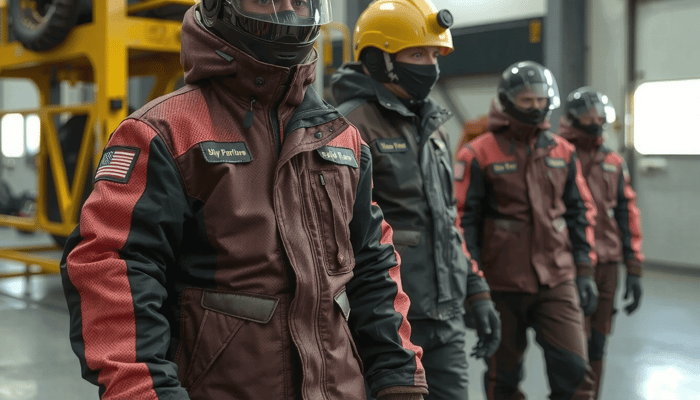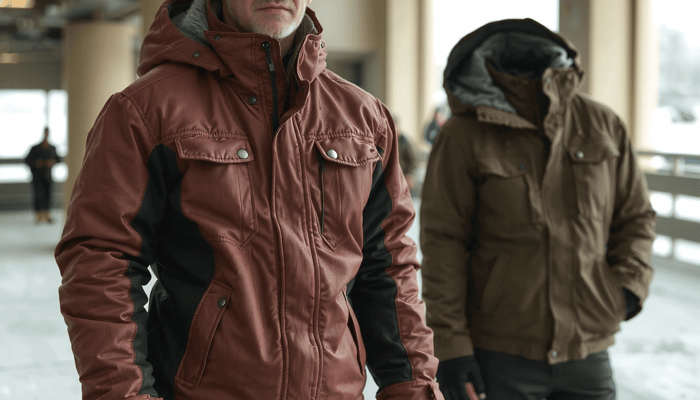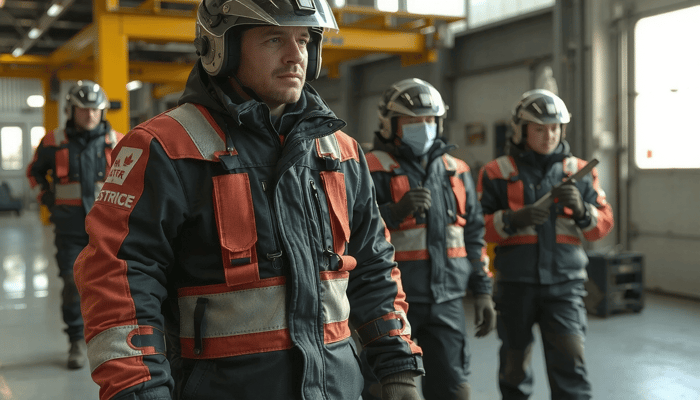Are Heated Jackets Safe? The Definitive Guide to Technology, Risks, and Safe Usage
 Mr. Eton Yip | 32+ Year Garment Manufacturing Expert & Founder of Eton Garment
Garment Industry
Mr. Eton Yip | 32+ Year Garment Manufacturing Expert & Founder of Eton Garment
Garment Industry
July 18th, 2025
10 minute read
Table of Contents
- How Heated Jacket Technology Ensures Your Safety
- Debunking the 4 Biggest Myths About Heated Jacket Safety
- A Buyer's Guide: How to Spot a Genuinely Safe Heated Jacket
- The Ultimate Guide to Safe Use and Maintenance
- Special Safety Considerations: Who Should Be Cautious?
- The Final Verdict: Are Heated Jackets Safe?
- Frequently Asked Questions (FAQ)
- FAQs
Let's get straight to the point. Yes, heated jackets are very safe when you buy them from trusted manufacturers and follow the instructions. The technology has come a long way from simple wires and batteries.
Many first-time buyers worry about electric shock, fire risks, or battery problems. This guide will explain the technology behind modern heated clothing. We'll cover all the safety features, clear up common myths, and give you the expert knowledge you need to choose and use a heated jacket safely.
How Heated Jacket Technology Ensures Your Safety
Understanding what's inside your jacket is key to trusting it. Modern heated jackets aren't just clothes with wires. They're advanced wearable technology with multiple layers of protection. Safety is built into every part of the design.

The Low-Voltage Power Source
Heated jackets run on low-voltage Direct Current (DC) power. This usually comes from a 5V, 7.4V, or 12V rechargeable battery pack. This is a crucial safety feature.
Here's some perspective: the human body typically feels a significant shock at around 36V. Heated clothing uses power sources well below this level. This makes the risk of serious electric shock almost zero, even when wet.
The Heating Elements: Carbon Fiber, Not Old Wires
Forget about stiff, fragile copper wires from the past. Today's quality heated jackets use flexible heating panels made from carbon fiber or graphene threads.
These advanced materials are woven into thin, durable panels. They're placed in key areas like the chest, back, and pockets. They spread heat evenly, which prevents dangerous hot spots. They're also tough enough to handle bending, folding, and daily wear without breaking.
The Brains: Built-in Safety Microcontrollers
Every quality heated jacket has a small computer called a microcontroller. This acts as the jacket's safety-focused brain. It constantly watches the temperature and power flow.
These jackets have intelligent temperature regulation systems. They include automatic shut-off timers to prevent continuous, unattended use. They also have thermal protection sensors that cut power if the temperature gets too high.
Debunking the 4 Biggest Myths About Heated Jacket Safety
Despite the advanced technology, false information can cause unnecessary worry. Let's tackle the most common fears with facts. Knowing whether are heated jackets safe often means telling myth from reality.
Myth 1: "I'll get electrocuted, especially in the rain."
Fact: The low-voltage system protects against electrocution. Reputable brands also design their jackets with water-resistant outer shells. All wiring and connectors are insulated to protect electrical components from moisture. This makes them safe for use in snow and light rain. However, they're not meant for full submersion.
Myth 2: "The jacket will catch fire or the battery will explode."

Fact: This is extremely unlikely with a quality product. The carbon fiber heating elements have an ignition point over 1800°F (1000°C). The jacket's battery could never produce this temperature. Trusted manufacturers use UL-certified lithium-ion batteries. These have built-in circuits to prevent overcharging, over-discharging, and short-circuiting. This is the same technology that safely powers your smartphone. These brands adhere to strict safety standards to minimize these risks.
Myth 3: "Heated jackets emit harmful EMF radiation."
Fact: Heated jackets do emit electromagnetic fields (EMF). But it's extremely low-frequency (ELF) EMF. This is the same type produced by any device powered by a DC battery. This isn't the same as ionizing radiation (like X-rays), which is known to be harmful. The EMF levels from a heated jacket are like other common household electronics. They're well within internationally accepted safety limits.
Myth 4: "They're bad for your skin or can cause burns."
Fact: The heat settings on a heated jacket are designed for comfort and therapeutic warmth, not to burn. The built-in temperature controls and even heat distribution of carbon fiber panels prevent dangerous hot spots. For maximum safety, especially for those with sensitive skin, start on the lowest setting. Avoid prolonged use directly against bare skin.
A Buyer's Guide: How to Spot a Genuinely Safe Heated Jacket
The market has many options, and they're not all the same quality. Your safety depends on choosing a product from a manufacturer that focuses on quality control and certified components. Here's what to look for.
Look for Safety Certifications
This is essential. Check the battery and charger for key certification marks.
- UL (Underwriter Laboratories): A North American certification showing the product has been tested to meet strict safety standards for fire and electrical shock.
- CE (Conformité Européenne): A mark showing the product meets health, safety, and environmental protection standards for products sold in the European Economic Area.
The Anatomy of a Safe Jacket vs. a Risky One
Use this table as a quick reference when shopping. This checklist can help you determine if the heated jacket you're considering is truly safe.

| Feature | ✅ High-Quality (Safe) Jacket | ❌ Low-Quality (Risky) Jacket |
|---|---|---|
| Battery | UL/CE Certified, clear brand/specs | Uncertified, no-name, vague branding |
| Heating Elements | Flexible Carbon Fiber / Graphene | Stiff, bulky copper wiring |
| Wiring | Insulated, flexible, reinforced connectors | Thin, exposed, flimsy connectors |
| Fabric & Build | Water-resistant, durable stitching, quality zippers | Cheap material, poor construction, weak seams |
| Brand & Warranty | Reputable brand, clear warranty & support | Unknown seller, no warranty or contact info |
Why Quality Manufacturing Matters
The safety of the electronics is only as good as the garment that houses them. A well-made jacket from an experienced clothing manufacturer protects the heating elements and wiring. It shields them from daily wear and tear, moisture, and physical stress. For those interested in what defines high-quality garment construction, looking at established clothing makers like china-clothing-manufacturer.com can provide valuable insight into the craftsmanship that ensures durability and longevity.
The Ultimate Guide to Safe Use and Maintenance
From years of using heated gear in everything from frozen job sites to backcountry ski trips, we've learned something important. Proper use and care are just as important as the initial purchase. Following these best practices will keep your jacket safe and effective for years.
Pre-Use Safety Checklist (Every Time)
- Inspect: Before each use, take 10 seconds to check the power cable for fraying or damage. Look at the battery to make sure it isn't swollen or cracked.
- Connect: Make sure the cable is securely plugged into the battery pack before turning the system on. A loose connection can cause power problems.
- Test: Briefly turn the jacket on and wait for the indicator light before you put it on. This confirms the system is working correctly.

Best Practices for Washing Your Heated Jacket
Yes, you can wash it! Just follow these steps exactly.
- Step 1: Always remove the battery pack. This is the most important step.
- Step 2: Zip the pocket containing the power cable closed. Make sure the connector cap (if included) is on.
- Step 3: For best results, place the jacket in a mesh laundry bag. Wash on a gentle or delicate cycle using cold water and mild detergent.
- Step 4: Never use bleach or fabric softeners. Never put the jacket in a dryer or wring it out forcefully. Hang dry completely before reconnecting the battery.
Storing Your Jacket Safely
For off-season storage, don't just throw it in a closet.
- Store the battery separately from the jacket in a cool, dry place.
- To keep the lithium-ion battery healthy long-term, charge it to about 50% before storing it for several months.
Special Safety Considerations: Who Should Be Cautious?
While heated jackets are safe for most people, certain individuals should be extra careful.
Individuals with Medical Devices or Conditions
We strongly recommend that people with pacemakers, implanted defibrillators, or insulin pumps talk to their doctor before using a heated jacket. The close proximity of the battery and heating elements could, in rare cases, interfere with these devices. Similarly, pregnant women and those with conditions that cause poor circulation or reduced skin sensation (like diabetes) should seek medical advice first.
Traveling with Your Heated Jacket
You can absolutely fly with your heated jacket. According to TSA rules, the jacket itself can be in your checked bag or worn onto the plane. However, all spare lithium-ion batteries must be in your carry-on luggage. It's always smart to check your specific airline's rules. Be prepared by following the manufacturer's instructions for travel.
The Final Verdict: Are Heated Jackets Safe?
After reviewing the technology, the risks, and the proper procedures, the answer is a confident "yes." Modern heated jackets are safe. You just need to invest in a quality product from a reputable brand and use and maintain it responsibly. The warmth and comfort they provide can completely change your experience in the cold.
Frequently Asked Questions (FAQ)
Can I wear a heated jacket while sleeping?
A: It's not recommended. Continuous, unattended heat application, even at low levels, can risk low-temperature burns. You can't monitor the jacket's performance or your skin's reaction while asleep. Always turn it off before sleeping.
Will the jacket still be warm if the battery dies?
A: Yes. A well-made heated jacket is also a high-quality insulated jacket. The shell, lining, and insulation materials will continue to provide significant warmth by trapping your body heat, just like a traditional winter coat.
Can I use a different brand's battery with my jacket?
A: We strongly discourage this. Mismatched voltages, amperage, or physical connectors can damage the jacket's heating elements. They can ruin the battery and create a serious safety hazard. Always use the battery and charger that came with your specific jacket.
How long does a heated jacket battery last on one charge?
A: This varies significantly based on the battery's capacity (mAh), the heat setting you use, and the number of heating zones. As a general rule, you can expect 2-4 hours on the highest setting and up to 10+ hours on the lowest setting.
Is it safe to wear a heated jacket on a motorcycle?
A: Yes, this is an extremely popular and safe use for heated gear. It's a fantastic way to extend the riding season in comfort. Make sure the jacket fits snugly to prevent it from flapping in the wind. Double-check that all wires are secure and tucked away.
Related Articles
Re-Waterproof: The Complete Handbook on How to Fix a Rain Jacket
11 minute read
July 18th, 2025
Your gear is perfect. Water is still beading up on your jacket and just rolling off? Gosh! It seems more... more »
What to Wear with a Jean Jacket: The Ultimate Guide for 2025
12 minute read
July 18th, 2025
The jean jacket is a real fashion icon. It's timeless and adaptable, a necessary element in every... more »
What Is a Varsity Jacket? The Ultimate Guide to an American Icon
11 minute read
July 18th, 2025
So, what is a varsity jacket? It's a classic piece of American outerwear. The wool body,... more »
The Complete Guide: How to Wash a Leather Jacket Without Ruining It
10 minute read
July 18th, 2025
Introduction: The Truth About "Washing" Your Leather JacketWhen you wonder how to wash a leather... more »
The Ultimate Guide: Washing a Down Jacket So It Will Serve You for a Long Time
12 minute read
July 17th, 2025
Down jackets made of good and quality materials are a great investment. You can wear it all day and feel... more »

